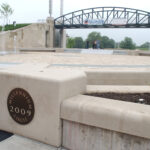The Lackawanna River Heritage Trail is a wonderful local asset that I have been enjoying for years. The trail was created and is maintained by the efforts of many individuals, organizations and government entities, which are coordinated by the Lackawanna Heritage Valley Authority (lhva.org).
The LHVA is a Lackawanna County authority formed in 1991 to oversee the Lackawanna Heritage Valley National and State Heritage Area. This area, which encompasses the Lackawanna River watershed in Lackawanna, Susquehanna, Wayne and Luzerne counties, has been recognized by Congress for its unique historical, cultural, recreational and natural resources.
The website is a good starting point for anyone who wants to access the trail. A link at the top of the site takes you to the Heritage Trail section. There’s general information about the trail, but the most useful feature is the maps of the different trail sections. There are four sections: Lower Valley (9.6 miles), Scranton (6.1 miles), Mid Valley (9.2 miles), and Delaware & Hudson Rail-Trail (35 miles). The D&H trail is technically a different trail, but they connect seamlessly.
While all the maps are helpful, they are not all equal. The Lower Valley has a link to an interactive map and a link to a static map locating the trailhead. The first link opens up a separate browser tab that features a Google-type map. You can zoom and pan to view different parts of the trail at different levels of detail. There are mile markers so you can plan the length you want to walk, run or bike on the trail. There’s a tool called Milermeter that lets you draw, save and share custom routes on the map. It will calculate the distance and calories burned for you. It’s a nice feature, but it takes practice to master.
The link to the static trailhead map is less useful. The map has limited detail, and there are no navigation links on the page, so you have to use the back button to return to the site.
The Scranton section has four links covering different aspects of the trail. These are also static maps with no navigation links to the rest of the site. They have some good information but are not as useful as an interactive map.
The Mid Valley section is like the Scranton section. It has three links to static maps of limited utility and no navigation links. They appear to be graphics from printed materials that were posted on the site. The static maps don’t share the visual style of the rest of the site.
The Delaware & Hudson section is like the Lower Valley. It has a link to an interactive map that opens in a separate tab and a link to a static trailhead map with no navigation. There’s also a link to the Rail-Trail Council of NEPA’s website.
Many running, walking and biking events are held on sections of the trail. You can download a registration form on the site if your group is interested in hosting an event.
The Lackawanna Heritage Valley site is about more than just the river trail. It has features on other local attractions and events as well as links to other sites of local interest.
The site has good visuals and typography, but the style and navigation are inconsistent. Some links take you off the site unexpectedly and some take you to pages with no navigation links. It’s a useful site that could use a little refurbishing to live up to its potential.

Kevin OʼNeill has been a staff artist for The Times-Tribune since June 1993. In addition to doing illustrations and infographics and designing pages for the paper’s print and electronic publications, he writes InSites, a weekly column about websites and apps. Contact: koneill@timesshamrock.com; 570-348-9100 x5212




